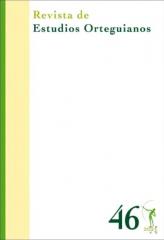Ortega, reader of Dante
DOI:
https://doi.org/10.63487/reo.77Keywords:
Ortega y Gasset, Dante Alighieri, Victoria Ocampo, Divine Comedy, loveAbstract
Ortega's connection with the work and figure of Dante, the greatest Italian poet of the Middle Ages, inspires the treatment of many essential themes of his thought and even constructs a vital metaphor in which he appropriates words and gestures that illuminate some of his most intimate decisions. For this analysis we have proposed the following categories: 1. The appeal to Dante's example or authority; 2.The metaphor in philosophical perspective; 3. Dante, representative of the spirit of the Italian Middle Ages; 4. Affectivity in crisis; 5. "Love of cortezia" and "Gioconda of the Pampa". The constant presence of Dante demonstrates his intimate pre-dilection for the Florentine's words, which were already part of his early writing materia.
Downloads
References
ARQUÉS, Rossend (2012): “Victoria Ocampo: il desi- derio tra Francesca, Beatrice e Dante”, [on- line], en Leggere d’Amore, Rimini, 2012, pp. 53-81. Dirección URL: https://www.academia. edu/9064273/Victoria_Ocampo_il_deside rio_tra_Francesca_Beatrice_e_Dante_in_Le ggere_damore_Rimini_2012. [Consulta: 29, julio, 2021].
AUERBACH, Erich (2000): Mimesis. La representación de la realidad en la literatura occidental. 1.ª ed. 1946. México: Fondo de Cultura Económica.
BATTISTESSA, Ángel J. (2003): La Divina Comedia. Buenos Aires: Asociación Dante Alighieri.
CAMPOMAR, Marta (2001): “Victoria Ocampo en la cultura del amor de Ortega y Gasset”, Revista de Estudios Orteguianos, n.°3, pp. 209-290.
CARPINTERO, Helio (1999): “Antonio Rodríguez Huéscar: filosofía y novela”, Revista de Occidente, n.° 216, mayo, pp. 35-53.
CARRASCO BARRANCO, Matilde (2019): “Naturaleza y valor de la Literatura” [Online], Disputatio, vol. 8, n.º 10. Dirección URL: http://www. disputatio.es. [Consulta: 19, abril, 2021].
CARRISCONDO ESQUIVEL, Francisco M. (2005): “Biografía de dos temas orteguianos: la creatividad léxico-semántica y el diccionario”, Revista de Estudios Orteguianos, n.° 10/11, pp. 219-244. GUZMÁN, Flora (1984): “La mujer en la mirada de Ortega y Gasset”, Cuadernos Hispanoameri- canos, n.° 403-405, pp. 179-190.
KARAGIANNIS, Stylianos (2009): Las verdades de Clío y Erato. Ensayos filosófico-literarios sobre Ortega y Gasset. Granada: Comares.
LAKOFF, George y JOHNSON, Mark (1991): Metáforas de la vida cotidiana. Madrid: Cátedra.
MARTÍN, Francisco José (1999): La tradición velada. Ortega y el pensamiento humanista. Madrid: Biblioteca Nueva.
MARTÍN, Francisco José (2013): “Filosofía y Litera- tura en Ortega. (Guía de perplejos de filosofía española)”, en Javier ZAMORA BONILLA (ed.), Guía Comares de Ortega y Gasset. Granada: Comares, pp. 171-188.
MARTÍN, Francisco José (2019): “Azorín y la retórica del humanismo. Forma y estilo de El Político”, [Online], Disputatio, vol. 8, n.º 10. Dirección URL: http://www.disputatio.es. [Consulta: 19, abril, 2021].
OCAMPO, Victoria (1931): “Contestación a un epílogo de Ortega y Gasset”, Sur, año I, otoño, pp. 16-48.
OCAMPO, Victoria (1980): Autobiografía, vol. II: “El imperio insular”. Buenos Aires: Editorial Sur.
OCAMPO, Victoria (1981): Autobiografía, vol. III: “La rama de Salzburgo”. Buenos Aires: Editorial Sur.
OCAMPO, Victoria (1983): De Francesca a Beatrice. Buenos Aires: Fundación Sur.
ORTEGA Y GASSET, José (2004-2010): Obras completas, 10 vols. Madrid: Fundación José Ortega y Gasset / Taurus.
PELOSSI, Claudia T. (2016): “Victoria Ocampo: una Dama del Mar sulle sponde italiane”, Gramma, vol. 27, n.º 56, pp. 77-95.
PÉREZ CARRASCO, Mariano (2012): “Hacia una Filosofía de la Lengua Vulgar. Filosofía, poesía y traducción en el Convivio dantesco”, Scientia Traductionis, n.º 11, pp. 207-227.
SALAS ORTUETA, Jaime de (1997): “La metáfora en Ortega y en Nietzsche”, en DOMÍNGUEZ, Atilano; MUÑOZ, Jacobo y SALAS, Jaime de (coords.), El primado de la vida. (Cultura, Estética y Política en Ortega y Gasset). Cuenca: Ediciones de la Universidad de Castilla-La Mancha, pp. 155-168.
SEVILLA FERNÁNDEZ, José M. y BARRIOS CASARES, Manuel (2000): Metáfora y discurso filosófico. Madrid: Tecnos.
VÁZQUEZ, María Esther (2002): Victoria Ocampo. El mundo como destino. Buenos Aires: Seix Barral.





